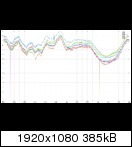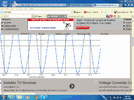I doubt it's the weather as, like i say i'm getting a stronger signal in torrential rain now than i would in torrential rain 3 months ago. I wonder if it's to do with the tilt of the earth?
I've thought for a long time that the forces originated by the sun are one of the major factors which makes the satellite move.
A few weeks ago i've found this treasurechest:
http://microsat.sm.bmstu.ru/e-library/Algorithms/algorithms.htm
In there especially this PDF:
http://microsat.sm.bmstu.ru/e-library/Algorithms/CommonDesign/Chapter2SatelliteDynamics.pdf
which describes very well how it's working.
I cite:
The torque resulting from solar pressure is the major long-term disturbance torque
for geosynchronous spacecraft.
...
For momentum bias and three axis stabilized spacecraft the major
portion of the solar pressure torque is usually due to the solar panels that track the sun.
Usually the solar panels only have a single gimbal, which is about the 3-axis or pitch
axis. Thus, they are always within 23 degrees of the Sun and the loss of power from not
pointing directly at the sun is offset by not having the added complexity and weight of a
double gimbal system to directly track the Sun.
...
Note that the pitch torque is periodic, hence its effect over one orbit is zero. However, the
roll and yaw torques have secular components which mean that over one orbit there will
be a net change in the spacecraft angular momentum.
You can bet that the angle between the satellite and the sun plays an important role here.
Unfortunately, there are some issues. The change of SNR over time as i have posted it earlier is neither symmetrical, nor steady. Ie the SNR was already pretty bad beginning of march, while it started to improve again beginning of september.
Also, if you look at the picture there have been quite a few "jumps". The most prominent one starting on the 23rd of Oct. I fail to see how this could be explained only by the changed angle between the sun and the satellite.
Another interesting effect is that there is a summer and a winter curve.
Summer:

Winter:

The interesting part is the time between summer and winter "modes". There was no switch or slow transformation, it sometimes morphed back and forth again. That process took weeks.

My guess is that the attitude control computer somehow seems to want to stick to "last weeks" mode. Speculation.
The next spring will tell us more.




